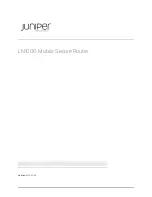
29-2
Cisco ME 3800X and 3600X Switch Software Configuration Guide
OL-23400-01
Chapter 29 Configuring IP Unicast Routing
Steps for Configuring Routing
Figure 29-1
Routing Topology Example
When Host A in VLAN 10 needs to communicate with Host B in VLAN 10, it sends a packet addressed
to that host. Switch A forwards the packet directly to Host B, without sending it to the router.
When Host A sends a packet to Host C in VLAN 20, Switch A forwards the packet to the router, which
receives the traffic on the VLAN 10 interface. The router checks the routing table, finds the correct
outgoing interface, and forwards the packet on the VLAN 20 interface to Switch B. Switch B receives
the packet and forwards it to Host C.
Types of Routing
Routers and Layer 3 switches can route packets in three different ways:
•
By using default routing—sending traffic with a destination unknown to the router to a default outlet
or destination.
•
By using preprogrammed static routes for the traffic
Static unicast routing forwards packets from predetermined ports through a single path into and out
of a network. Static routing does not automatically respond to changes in the network and therefore,
might result in unreachable destinations.
•
By dynamically calculating routes by using a routing protocol
Steps for Configuring Routing
By default, IPv4 routing is disabled on the switch, and you must enable it before routing can take place.
For detailed IP routing configuration information, see the Cisco IOS IP Configuration Guide,
Release 12.2
In the following procedures, the specified interface must be one of these Layer 3 interfaces:
•
A routed port: a physical port configured as a Layer 3 port by using the no switchport interface
configuration command.
•
A switch virtual interface (SVI): a VLAN interface created by using the interface vlan vlan_id
global configuration command and by default a Layer 3 interface.
•
An EtherChannel port channel in Layer 3 mode: a port-channel logical interface created by using
the interface port-channel port-channel-number global configuration command and binding the
Ethernet interface into the channel group. For more information, see the
“Configuring Layer 3
EtherChannels” section on page 28-12
.
92996
A
B
C
Host
Host
Host
Switch A
Switch B
VLAN 10
VLAN 20
IEEE 802.1Q
trunks
















































